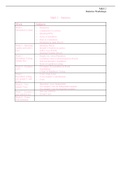Samenvatting
Summary M&S2 Fundamentals of Modelling and Simulation
- Vak
- M&S
- Instelling
- Hogeschool Van Amsterdam (HvA)
Summary of the theory of M&S2 Fundamentals of Modelling and Simulation. It is without the explanation of how the simulation is run in Simio.
[Meer zien]




